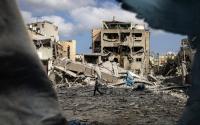Common Dreams / Published on Monday, December 24, 2007 by The Times OnlineAndrew Sullivan
Almost all of the time, the Washington I know and live in is utterly unrelated to the Washington you see in the movies. The government is far more incompetent and amateur than the masterminds of Hollywood darkness.
There are no rogue CIA agents engaging in illegal black ops and destroying evidence to protect their political bosses. The kinds of scenario cooked up in Matt Damon’s riveting Bourne series are fantasy compared with the mundane, bureaucratic torpor of the Brussels on the Potomac.
And then you read about the case of Abu Zubaydah. He is a seriously bad guy - someone we should all be glad is in custody. A man deeply involved in Al-Qaeda, he was captured in a raid in Pakistan in March 2002 and whisked off to a secret interrogation, allegedly in Thailand.
President George Bush claimed Zubaydah was critical in identifying Khalid Sheikh Mohammed as the mastermind behind 9/11. The president also conceded that at some point the CIA, believing Zubaydah was withholding information, “used an alternative set of procedures”, which were “safe and lawful and necessary”.
Zubaydah was waterboarded. That much we know - it was confirmed recently by a former CIA agent, John Kiriakou, who even used the plain English word “torture” to describe what was done. But we know little else for sure. We do know there was deep division within the American government about Zubaydah’s interrogation, and considerable debate about his reliability.
Ron Suskind’s masterful 2006 book The One Percent Doctrine recorded FBI sources as saying that Zubaydah was in fact mentally unstable and tangential to Al-Qaeda’s plots, and that he gave reams of unfounded information under torture - information that led law-enforcement bodies in the US to raise terror alert levels, rushing marshals and police to shopping malls, bridges and other alleged targets as Zubaydah tried to get the torture to stop. No one disputes that Zubaydah wrote a diary - and that it was written in the words of three personalities, none of them his own.
A former FBI agent who was involved in the interrogation, Daniel Coleman, said last week that the CIA knew Al-Qaeda’s leaders all believed Zubaydah “was crazy, and they knew he was always on the damn phone. You think they’re going to tell him anything?” Even though preliminary, legal interrogation gave the US good - though not unique - information, the CIA still asked for and received permission to torture him in pursuit of more data and leads.
The Washington Post reported that “current and former officials” said the torture lasted weeks and even, according to some, months, and that the techniques included hypothermia, long periods of standing, sleep deprivation and multiple sessions of waterboarding. All these “alternative procedures”, as Bush described them, are illegal under US law and the Geneva conventions. They are, in fact, war crimes. And they were once all treated by the US as war crimes when they were perpetrated by the Nazis. Waterboarding has been found to be a form of torture in various American legal cases.
And that is where the story becomes interesting. The Bush administration denies any illegality at all, insists it does not “torture” but refuses to say whether it believes waterboarding is torture or not. But hundreds of hours of videotape were recorded of Zubaydah’s incarceration and torture. That evidence would settle the dispute over the extremely serious question of whether the president of the United States authorised war crimes.
And now we have found out that all the tapes have been destroyed.
See what I mean by Hollywood? We know about the destruction because someone in the government told The New York Times. We also know the 9/11 Commission had asked the administration to furnish every piece of relevant evidence with respect to Zubaydah’s interrogation and was not told about the tapes. We know also that four senior aides to Bush and Dick Cheney, the vice-president, discussed the destruction of the tapes - including David Addington, Cheney’s right-hand man and the chief legal architect of the administration’s detention and interrogation policies.
At a press conference last Thursday the president gave an equivocal response to what he knew about the tapes and when he knew it: “The first recollection is when CIA director Mike Hayden briefed me.” That briefing was earlier this month. The president is saying he cannot recall something - not that it didn’t happen. That’s the formulation all lawyers tell their clients to use when they need to avoid an exposable lie.
This is not, of course, the first big scandal to have emerged over the administration’s interrogation policies. You can fill a book with the sometimes sickening details that have come out of Guantanamo Bay, Bagram in Afghanistan, Camp Cropper in Iraq and, of course, Abu Ghraib.
The administration has admitted that several prisoners have been killed in interrogation, and dozens more have died in the secret network of interrogation sites the US has set up across the world. The policy of rendition has sent countless suspects into torture cells in Uzbekistan, Egypt, Jordan and elsewhere to feed the West’s intelligence on jihadist terrorism.
But this case is more ominous for the administration because it presents a core example of what seems to be a cover-up, obstruction of justice and a direct connection between torture and the president, the vice-president and their closest aides.
Because several courts had pending cases in which testimony from Zubaydah’s interrogation was salient, the destruction of such evidence triggers a legal process that is hard for the executive branch to stymie or stall - and its first attempt was flatly rebuffed by a judge last week.
Its key argument is a weakly technical one: that the interrogation took place outside US territory - and therefore the courts do not have jurisdiction over it. It’s the same rationale for imprisoning hundreds of suspects at Guantanamo Bay in Cuba - a legal no man’s land. But Congress can get involved - especially if it believes that what we have here is a cover-up.
What are the odds that a legal effective interrogation of a key Al-Qaeda operative would have led many highly respected professionals in the US intelligence community to risk their careers by leaking top-secret details to the press?
What are the odds that the CIA would have sought to destroy tapes that could prove it had legally prevented serious and dangerous attacks against innocent civilians? What are the odds that a president who had never authorised waterboarding would be unable to say whether such waterboarding was torture?
What are the odds that, under congressional grilling, the new attorney-general would also refuse to say whether he believed waterboarding was illegal, if there was any doubt that the president had authorised it? The odds are beyond minimal.
Any reasonable person examining all the evidence we have - without any bias - would conclude that the overwhelming likelihood is that the president of the United States authorised illegal torture of a prisoner and that the evidence of the crime was subsequently illegally destroyed.
Congresswoman Jane Harman, the respected top Democrat on the House intelligence committee in 2003-06, put it as simply as she could: “I am worried. It smells like the cover-up of the cover-up.”
It’s a potential Watergate. But this time the crime is not a two-bit domestic burglary. It’s a war crime that reaches into the very heart of the Oval Office.
Yes, it is Hollywood time. And the ending of this movie is as yet unwritten.






